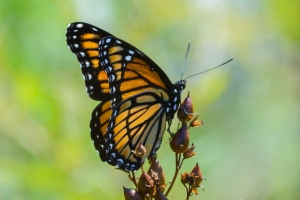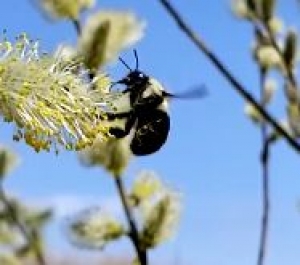

Ethan Bott
Ethan Bott is the GIS and Field Data Coordinator for all three branches and is a part of the Research and Community Science Team. He graduated from the University of Wisconsin-Stevens Point studying Hydrology and GIS. Ethan has been a longtime volunteer, a high school Outdoor Leader, a summer intern, and now he is part of the staff! When he’s not busy crunching numbers or making maps, you will find him backpacking, kayaking, skiing, fishing or doing any number of fun activities outside. He hopes to make ecology and conservation a true community effort where the people doing the science are just as diverse as the subjects being researched.
Milwaukee Winter Phenology Challenge and Fall Results
Back in September, the Urban Ecology Center challenged you to help document signs of fall using the free mobile phone app, iNaturalist, to record and submit wildlife and plant sightings to an international dataset. There were almost 400 observations that were submitted spanning 45 different species from September through November! New England Aster was by far the most documented species with 90 observations. Canada Goldenrod and Calico Aster were next two most documented species with the Asian Lady Beetle coming into fourth with 25 observations. Nice job to everyone documenting some sure signs of fall and participating in the Fall Phenology Challenge! Be sure to check out the results of the Fall Phenology Challenge here
Milwaukee Fall Phenology Challenge and Summer Results
Back in June, the Urban Ecology Center challenged you to help document signs of summer using the free mobile phone app, iNaturalist, to record and submit wildlife and plant sightings to an international dataset. And wow – there were over 600 summertime observations that were submitted! With your help, 59 species were identified, which nearly met our total summertime challenge species goal! Some species of plants that evaded documentation were the Prairie Spiderwort and the Yellow Coneflower. On the wildlife list, both the Common Yellowthroat and the Dekay’s Brownsnake were left undocumented.
Backyard Birding Blitz: Fall Migration
While springtime has long ago passed and with social distancing and mask wearing highly recommended, the Urban Ecology Center is excited to announce our first ever Fall Backyard Birding Blitz on Saturday, September 12th! As the birds start their journey back down south to warmer places for the winter, that means that they will be stopping by in Milwaukee and in cities and places from around the country. Come join us in observing and documenting the beautiful birds as they migrate south. Similar to the Green Birding Challenge in spring, some of the rules will sound familiar – you can choose between one of three challenges where you will try to record as many different species of birds as possible without using fossil fuels. The goal of this event will be the same: to connect people to the wonders of our local birds, and rather than gathering in one place, we are going to explore our own backyards and neighborhoods in a socially distant way.
Nocturnal Yardversity: Exploring the Night-time Diversity in Your Backyard
As we continue off of the success of our Yardversity event from July, we are excited to share that we will be offering a monthly version of Yardversity for the foreseeable future. This continues on Thursday night, August 20th from 8:00 - 10:00pm CST as we document the incredible night time diversity, especially those nocturnal insects that flood your porch and street lights.
Milwaukee Summer Phenology Challenge and Spring Results
Back in March, the Urban Ecology Center challenged you all to help document signs of spring in Milwaukee using iNaturalist (free mobile phone app) as a means of documenting and submitting data to an international dataset. There were nearly 400 springtime observations that you all recorded! You all helped identify 32 species which is nearly all of the species we challenged you with spotting. I couple of species that eluded documenting, was the Pasque Flower and the Spring Peeper. Both can be tough to spot! Additionally, we had 84 people submit data that fit within our phenology challenge requirements. Bloodroot had the most number of identifications with 44 people spotting it.
The Royal Relationship between Queen Bees and Spring Ephemerals
Co-authored by Jeff Veglahn.
Recently in early April, Jeff Veglahn, Land Steward at our Menomonee Valley Branch, spotted a bumble bee flying around and was able to capture an incredible video of it landing on a willow to feed.
This interaction may seem common enough, but after careful identification of the bee, the video became more exciting than initially thought! What was captured on film was actually a Two-spotted Queen Bumble bee which is one of about twenty bumble bee species in Wisconsin. This was the first recorded sighting of a queen bumble bee of any kind in Milwaukee County this year and one of the very first in the state for this year.
How you can Connect to Nature and Contribute to Research!
We know COVID-19 is affecting everyone in Milwaukee County in many different and difficult ways. We are now spending a lot of time indoors living, working, and teaching as we care for ourselves and one another through physical distancing. However we also know that nature has incredible healing and calming powers that we want you to take advantage of during this stressful time. Whether that is in your backyard, in a park, or even through your window, we hope you have the chance to interact with the outdoors. Before you head outside, please abide by all health and social distancing recommendations by the CDC as well as by local health officials as they can change with every passing day. Please use your best judgment as your safety and ultimately the public’s safety is of utmost importance.
A Sucker for Sapsuckers
One of my earliest interactions with a bird happened when I was a child. However, it was not actually with a bird, but instead an interaction with the source of its food. Every year as a child my family and I would pack up the car and head up to the great north woods to our log cabin situated on a small lake. In front of our cabin there was a birch tree just feet from the edge of the lake.
Help us Monitor Nocturnal Animals at a Mini-BioBlitz
Bring your friends and family and help us count and document the different animal species in the parks we manage this summer during our Mini-BioBlitzes.
Before we get any further, what the heck is a BioBlitz? Well, a BioBlitz is typically a 24-hour event that focuses on finding and identifying as many species of plants, animals, fungi, and any others organisms as possible in one area. The goal is to create a snapshot in time of everything that is present.
Experience the nocturnal biodiversity and ecological richness of the natural areas around our three branches during a 2-hour Mini-BioBlitz on July 22nd at Washington Park, August 19th at Riverside Park and August 21st at Menomonee Valley.
Copyright © 2023 The Urban Ecology Center











